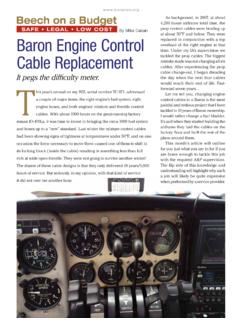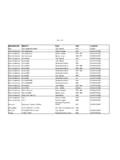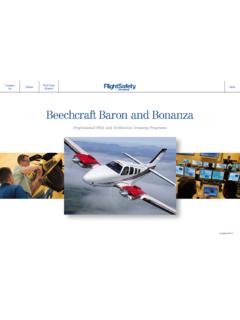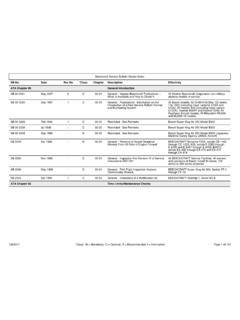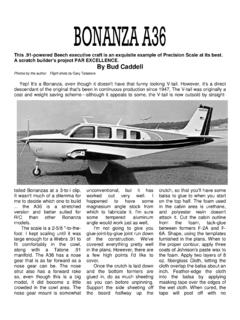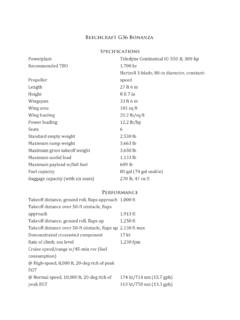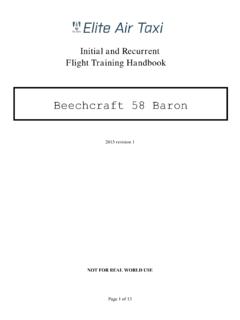Transcription of www.aopa.org , 10/01/2002 Beechcraft Travel Air: Baron Lite
1 , 10/01/2002 Beechcraft Travel Air: Baron Lite Beech's first true light twin In the mid-1950s, Beechcraft called its Twin bonanza a "light" twin. But the Twin bonanza 's 6,000-pound-plus max takeoff weight was significantly heavier than light twins from other manufacturers, namely Piper's Apache and Cessna's 310. The Twin bonanza (see " Beech Twin bonanza : A Legend Roars On," September 1999 Pilot) and Ted Smith's Twin Commander were in their own microcategory of, shall we say, "not-so-light twins." Seeing the success that Piper and Cessna were having with their respective light twins, Beech engineers went to the parts bins and pulled out some pieces from the company's popular bonanza and its T-34 military trainer to create a smaller twin.
2 With the various parts and pieces, Beech created what was to be known as the Badger. First flight of the Badger was in 1956. Powered by a pair of carbureted Lycoming O-360s of 180 horsepower each, the Badger proved to be more like a bonanza with its power divvied up between two engines. It utilized a standard bonanza cabin rather than the wide-body Twin bonanza 's. Unfortunately for Beech, the Badger name wasn't going to work because the name had already been chosen by the military to identify a Russian bomber. The company then chose a name with which Walter Beech was very familiar Travel Air, the name of the company formed by Beech, Lloyd Stearman, and Clyde Cessna in the 1920s.
3 The new(er) Travel Air is easily distinguished from its biplane namesake as well as more modern Beech twins most notably the Baron by its blunt nacelles and straight tail. The tail and landing gear are from the military's T-34 Mentor trainer. Otherwise, the little twin was constructed of mostly bonanza parts. Earlier Model 95s had small third- cabin windows like the Bonanzas of the time. The B95, introduced in 1960, upped the maximum gross weight by 100 pounds (to 4,100 pounds) and featured a cabin stretch of 19 inches. Beech also added a standard forward-facing fifth seat as opposed to the optional side-facing jump seat, offered in the 1959 model year. The B95A came in 1961 and marked some of the biggest changes to the Travel Air.
4 Among the more noteworthy changes were fuel injection, a longer cabin with an available sixth seat, a max takeoff weight increase to 4,200 pounds, wider-chord flaps to retain stall speed at the higher gross weight, and larger third windows. The D95A was introduced in 1963, featuring an extended nose baggage compartment, Bendix fuel injection to replace the more troublesome Simmonds system, and a redesigned instrument panel. The D95A continued production through 1967 with many minor improvements, such as the addition of a one-piece windshield in 1966 and the controversial "Magic Hand" landing gear safety system. The last model of Travel Air was the E95A in 1968, which featured the more slanted "speed sweep" windshield and new paint and interior designs.
5 Utilizing experience gained with the Travel Air, Beechcraft introduced the Model 55 Baron in 1961. Save for the swept tail and slim nacelles enclosing 260-hp Continental IO-470s, the new Baron was nearly identical to the Travel Air. The Baron allowed Beech to better compete with Cessna's speedy 310 and Piper's new Aztec. The Travel Air and Baron were produced alongside each other for seven years. By 1968 most buyers were opting for one of the two available Baron models. In that year sales of the Travel Air had fallen to just 14 airplanes and production was halted. Travel Airs have been placed into a microcategory of the original light, light twins. Others in the group are the Piper Twin Comanche and the Piper Apache.
6 Their low fuel burn and nearly bulletproof engines make these three airplanes extremely popular multiengine trainers. Despite the introduction of the more-modern Piper Seminole and Beechcraft Duchess twin trainers in the late 1970s, Travel Airs soldiered on with similar or better performance than the new kids on the block. The same traits that make these airplanes popular for training make them popular owner-f lown twins as well. The fuel efficiency and low-maintenance engines make the Travel Air affordable to own. While most well-equipped Travel Airs lack the useful load to carry four adults, baggage, and full fuel, these airplanes are well suited to a family with two or three preteens.
7 Also appealing is the fact that Travel Airs possess the same responsive handling for which the bonanza / Baron family has become legendary. Crisp roll rates, spirited runway acceleration, and a good climb rate give the Travel Air a sportplane feel. Despite the chunky look of the tail and nacelles, the Travel Air is a clean airplane. Point the nose down and the speed will pick up rapidly. Like its bonanza and Baron brethren, the Travel Air is reluctant to slow down and go down at the same time. Like all light twins, the Travel Air is far less spirited on one engine, mustering a single-engine climb rate of 205 feet per minute (E95) in standard conditions at gross weight. Single-engine service ceiling is a paltry 4,400 feet.
8 In fairness, however, this is typical performance for light twins powered by four-cylinder engines of 160 to 200 horsepower. In addition, the earlier model 95s, which had lower max gross weights yet the same power, show better single-engine performance. Visibility through the expanse of acrylic is excellent, especially in the later models with the larger aft windows. This creates an open and airy feeling that distracts Travel Air passengers from the fact that the cabin is a narrow 42 inches. What the cabin lacks in elbowroom it makes up for in generous leg- and headroom. Those of wider girth may find the Apache/Aztec or Cessna 310 a little more comfortable. Travel Air pilots are subject to a common embarrassment that many other Beech pilots have discovered over the years inadvertent gear retractions on the ground.
9 Other light-twin manufacturers decided that the landing-gear switch should be placed on the left side of the power quadrant, despite the fact that heavier twins retained the switch on the right side. As a result, pilots, especially those who were trained in Pipers or Cessnas, would grab the landing-gear handle during the landing roll and fold the undercarriage. There is a squat switch designed to prevent this from occurring, but apparently some pilots grab the gear handle early in the landing roll before there's enough weight on the wheels to trip the squat switch. Also typical of the heavy twins of the era, the Travel Air's throttles are located in the center of the quadrant while the other light-twin manufacturers decided to place the throttles on the left side.
10 The Beech 18 and larger piston airliners had throttles in the middle to give the pilot and copilot equal access to the go-levers. Other light-twin manufacturers, who rationalized that these airplanes were most likely to be flown by a single pilot rather than a crew of two, placed the throttles on the left side of the power quadrant. This layout was targeted as the cause of sometimes-fatal accidents in which the pilot confused the prop lever for the throttle or vice versa. The Beech placement of the flap/gear switches and the throttle/prop levers eventually became nonstandard for light twins, and pilots switching between Beechcraft twins and light twins from other manufacturers often confused the placement with expensive and sometimes fatal results.
